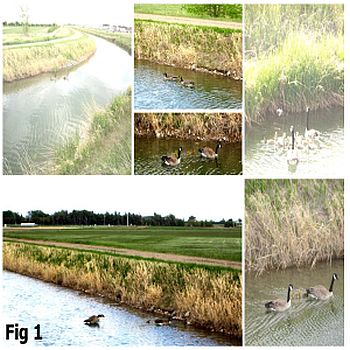Irrigation canals constitute an important nesting site for several aquatic bird species and have slowly transformed into an excellent natural habitat over the passing decades. Several wild aquatic bird species such as Canada geese (Branta canadensis L.; Fig 1) and mallard ducks (Anas platyrhynchos L.; Fig 2) have in particular found such canals as important nesting, resting, breeding and foraging sites across the Canadian Prairies. The lush vegetation that accompanies irrigation canals traversing across the municipalities and rural districts provides excellent nesting and hiding sites for the breeding aquatic species; while the water in the irrigation canal serves as important foraging ground. The dense vegetation protects the nests, eggs and nestlings from a host of predators making their breeding a success story across the Prairies.
Image may be NSFW.
Clik here to view.
Image may be NSFW.
Clik here to view.
The security of the bushes and the abundant supply of food, water, foraging and nesting resources have made certain stretches of the intricate network of irrigation canal a bold success story for several such aquatic bird species. During the breeding season large flocks are seen to be approaching the canal nesting sites in good numbers both by the mallards (Fig 3) and the Canada geese (Fig 4). Although a number of predatory birds and mammals do also nest in nearby trees (Fig 4) and bushes and woods to take advantage of the yearly bounty; particularly the highly vulnerable nestlings and fledglings such as the young and defenseless ducklings and goslings.
Image may be NSFW.
Clik here to view.
Image may be NSFW.
Clik here to view.
However, the greater number and close guards by the caring parents do not actually impact the species population and is in particular nature’s own monitoring in keeping the population under check (Figs 5-6). Hence, in a broader term a healthy and thriving population of the ducks and the geese actually positively contributes towards the stable population of the predatory birds and mammals too; further extending the success of the irrigation canals to other wildlife species. In addition to the mallards and Canada geese or black geese, other species of ducks and geese (such as the grey and white geese) are also known to take advantage of the refuge of the irrigation canal habitats along their annual migration routes. Several other non-aquatic bird species like the different black birds (Fig 5) that inhabit the ecotones between land and water also take advantage of the natural habitats produced by the irrigation canals.
Image may be NSFW.
Clik here to view.
Image may be NSFW.
Clik here to view.
Hence, the construction and development of the large network of irrigation canals across the Prairies have been an excellent natural resource that has been helping in building the population of local birds and in directly contributing towards establishing a sustainable environment. However, it will be important in future to do extensive bird surveys in and adjacent to such artificial habitats for monitoring the bird population and in better understanding the nature and behaviors of different species that have been intelligently using such available resources to their advantage. It is often interesting to note that anthropogenic activities that impact wildlife species so negatively could also have positive impacts in some other ways. It will be therefore important for us to learn from the experience and develop our future technologies in a pro-nature or environment friendly fashion so that we could effectively curb our foot prints on the nature and also successfully reduce our impacts on the population of different wild species of birds.
Article contributed by Saikat Kumar Basu
Related posts: